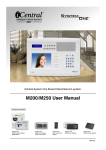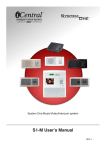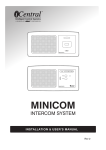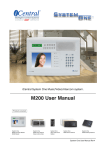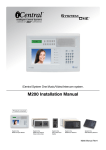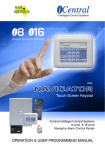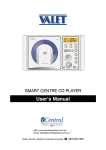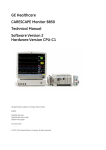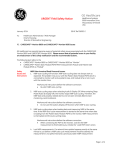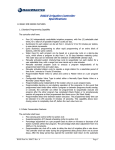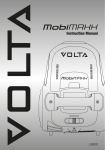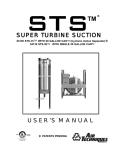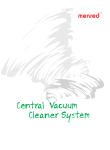Download iCentral Vacuum Owner`s Manual
Transcript
iCentral Vacuum System Owner’s manual Rev 2 Central Vacuum Intercom Security Automation www.icentralsystems.com.au Sales - Service - Spares 1300 050 333 Ness Head Office 02 8825 9222 Contents Safety Instructions . . . . . . . . . . . . . . . . . . . . . . . . . . . . . . . . . . . . . . . . . . . . . 4 Cleaning Tools . . . . . . . . . . . . . . . . . . . . . . . . . . . . . . . . . . . . . . . . . . . . . . . . 5 Vacuum Inlets. . . . . . . . . . . . . . . . . . . . . . . . . . . . . . . . . . . . . . . . . . . . . . . . . 5 Power Unit. . . . . . . . . . . . . . . . . . . . . . . . . . . . . . . . . . . . . . . . . . . . . . . . . . . . 5 Sealed Bag Systems How to Change the bag. . . . . . . . . . . . . . . . . . . . . . . . . . . . . . . . . . . . . . . . . 6 Cyclonic Systems How to empty the dirt canister. . . . . . . . . . . . . . . . . . . . . . . . . . . . . . . . . . . . 7 Troubleshooting Guide Table. . . . . . . . . . . . . . . . . . . . . . . . . . . . . . . . . . . . . 8 Troubleshooting Guide descriptions . . . . . . . . . . . . . . . . . . . . . . . . . . . . 9, 10 iCentral Vacuum Owners Manual Intended only for Household and Light Commercial Use Important Safety Instructions Before installation or use please proceed to: • Read the Installation Manual and ensure correct Installation • Read the User Manual and ensure correct use of the product/s at all times • Check and empty the dust bag or bin regularly •Do not install outside unless proper weather protection is in place •Do not connect to a non grounded supply or a no approved supply •Do not service the Motor Unit unless it has been disconnected from the supply •Do not use with a damaged electrical lead or plug •Keep electrical lead away from heated or sharp objects •Keep inflammable objects or liquids away from the Motor Unit •Do not place or store anything on top of the Motor Unit •Do not place or store anything that may restrict the air flow of the Motor Unit •Do not vent the Motor Unit into a wall, a ceiling, or any enclosed space •Do not vacuum on any wet surfaces •Do not vacuum any liquids, including any fuels •Do not vacuum anything that is hot, burning or smoking •Do not vacuum any ash, even it appears dormant •Avoid vacuuming plaster dust or talcum powder, which can cause clogging and bursting of vac bags •Do not obstruct, block or impede the hose or wall valve inlets •Keep hair, all parts of the body and loose clothing away from the hose or wall inlets •Do not use non recommended attachments or accessories •Pay close attention to children while the system is being used •Do not allow children to use the system as a toy Warning improper use may cause fire, electric shock or injury Operating Your Central Vacuum System Your central vacuum system has been engineered for a long, trouble-free service life. Your power unit is covered by a factory limited warranty that is enclosed with these instructions. Please read your limited warranty carefully. If your owners manual came with a warranty card, fill it out and return to iCentral. You should fill out your registration card within ten (10) days of installation and return to address listed on the card. Remember, your warranty does not cover abuse or misuse of the equipment. If your owners manual did not come with a warranty card, contact your dealer for warranty Information, or you can register online at www.icentralsystems.com.au CLEANING TOOLS It is very important to utilise the tool that is designed to perform a particular cleaning job, in order to obtain full efficiency from your system. There are also a range other special carpet & flooring tools available, which are not included as part of the normal tool kits. For example, these include, a vibrating upholstery tool, a pet grooming tool, and a hand held air turbine. In addition, there are accessories designed to allow you to safely pick up liquids with your cleaning system such as the Wet Pick-Up. Each of these tools is available for purchase from your local dealer. VACUUM INLETS When opening the door of the vacuum inlet wall valve to insert the cleaning hose, care should be taken not to distort the door by forcing it too far open. Do not turn the system on and try to open the door of another inlet, since this will tend to pull the rubber gasket from the door. If inlet does not have remote on/off hose activated, leave door open for a few seconds after removing hose from inlet so the cyclonic filtration has time to shut down and debris can settle back down into the dirt can. If the power unit continues to run after the hose is removed from the inlet, the small ball which activates the low voltage switch at the inlet (not all systems have these) should be checked to make sure it has not become lodged in some way. Should this not shut the unit off, disconnect the electrical supply to the power unit and notify your local dealer or serviceman. VACUUM POWER UNIT Your power unit does not require any oil. The bearings in the motor are greased and sealed for life. The motor of the unit has contact brushes inside. As the unit is used, the brushes will wear, even when functioning properly. Because of this, the brushes in most power units will need to be replaced after 700 to 1,500 hours of use. Brush life is also affected by humidity, altitude, temperature and the number of starts and stops. So, there is a wide spread in the actual life of the motor brushes. On average the life of the motor brush, when used in a normal manner, will be from ten to twenty years. The cost of replacing your motor brushes is not great; but, the damage that can be done to the motor through not replacing the brushes before they are completely worn out is considerable. We recommend that you have your unit and motor brushes inspected by a qualified serviceman every 4-6 years. Sealed Paper Bag Systems Sealed paper bag units incorporate a two-layer disposable paper bag for superior filtration. These paper bags are also inexpensive and easy to throw away making vacuum maintenance easy. The mass of dirt and debris picked up by your central vacuum system is deposited in the filter bag inside the dirt canister. To remove this accumulation, follow these simple steps: How to change the bag 1. Remove the lid by lifting straight up. There are no hinges or clamps. 1 2. Remove the bag by sliding the rubber gasket that surrounds the hole in the paper bag off the plastic inlet stem that protrudes through the side of the canister. Once the bag is off the inlet stem, seal the bag by removing the backing from the tab and cover the hole with the flap. Press the flap so that it securely seals over the hole. This will help prevent dirt and dust from escaping. Now, lift the paper bag from the dirt canister and place in a suitable trash container. 3. Take a new bag and extend it fully, place it in the canister, and slide the rubber gasket onto the inlet stem until the rubber gasket drops into place in the ridge that is around the inlet stem. 2 4. Carefully replace the lid on the dirt canister to ensure that it seals properly or it could cause a vacuum leak and reduce the cleaning efficiency of your system. NOTE. If you notice that a bag breakage has occurred, lift the plate located under the bag and clean any debris off the small screen filter. How Often Should I Check Or Empty The Paper Bag? 3 The filter bag should be changed or cleaned when there is 100–150mm of dirt or any time there is a noticeable reduction of air flow at the cleaning tool. Initially, the dirt canister should be checked or emptied weekly until some idea can be obtained as to how long it takes to half fill the canister under your normal cleaning routine. All vacuum systems will function more effectively if they are emptied frequently. Under no circumstances should you allow your dirt canister to become more than 3/4 full before emptying. Note: The canister will fill more rapidly when cleaning NEW carpets. There is usually a tremendous quantity of loose fibres that are retained in the carpet from the manufacturing process. In some instances it may take several months before all of these loose fibres are removed. Cyclonic & Inverted bag Systems The volume of dirt and debris picked up by your central vacuum system is deposited in the dirt canister or inverted bag. The dirt canister is attached to the bottom of your power unit (single canister units) or filter canister (if split system unit) and will need to be emptied on a periodic basis. To empty the dirt can or inverted bag , follow these simple steps: How to Empty the dirt canister Single Canister Units 1 4 1. To remove the dirt canister, support the bottom of the canister with your knee1, then unsnap the two dirt canister latches by grasping the lower end of each latch and pulling straight away from the canister. (Note: The latches may be tight, but do not try to adjust them. They need to latch tightly, to ensure a proper seal, which is important in the operation of the cyclonic separation.) 2. Carefully lower the dirt container and empty the debris into any suitable trash container. 3. Cyclonic Units - check the vacuum protection screen by looking up or feeling up inside the dirt canister to remove any debris that may have become stuck on the screen up inside the metal cone. A plastic bag may be placed over the bottom portion of the top canister. Then, while holding the plastic bag tightly around the canister with one hand, push the bag up inside with the other hand and brush the screen surface. In this way, the screen can be cleaned without getting any dust or debris on the floor or hands. Some Cyclonic units may have an optional Electro-Static screen. To remove the screen, pull down on the tab until the screen comes down through the metal cone. Clean the electrostatic screen by vacuuming, rinsing with water, or shaking. IMPORTANT: If you rinse the screen, make sure it is dry before placing it back in the unit or it will void warranty. To replace the screen, fold it and place it inside of the top of the metal cone. Then, allow the Electro-Static screen to expand until it covers the entire opening. Inverted Bag Units - It is not necessary to remove the inverted bag to clean. A plastic bag may be placed over the bottom portion of the top canister. Then, while holding the plastic bag tightly around the canister with one hand, push the bag up inside with the other hand, and brush/shake the bag surface to loosen any dust and debris that may have accumulated on the bag. In this way, the bag can be cleaned without getting any dust or debris on the floor or hands. Ideally, the bag should be cleaned every time you empty the dust bin. 2 4. Replace the dirt canister by slipping the rim of the dirt canister over the lip of the top can until it is seated against the rim gasket. Then while holding the canister in place with your knee1, fasten the two latches. Do this by hooking the top lip of each latch over the rim of the top can and then press straight in on the bottom of the latches until they lock. 1 If you have trouble removing or replacing the dirt canister using your knee, try supporting the can with one hand, unlatching (or re-latching) one side with the other hand. Then, reverse your hands to unlatch (or re-latch) the other side. TIP. When cleaning the up inside the can, try using a (new) toilet bowl brush or similar brush. This will allow you to reach up inside more easily than just by using your arm. You should still use the plastic bag as described above, as this will keep the dirt from falling on you or the floor. Troubleshooting Guide Your iCentral Vacuum System has been engineered and manufactured to provide many years of carefree service. Should your system fail for any reason, the following chart and instructions will assist you to restore good working order. Cause Symptom Check each X for a Probable Cause Power Unit does not run No Airflow Low Airflow 1. Power Cord x x 2. Unit Circuit Breaker x x 3. Home Circuit Breaker x x 4. Unit Thermal Switch (some models) 5. Electrical power point x X x x x X 10. Flexible hose blocked x x 11. PVC ducting blocked x x 12. Dirt canister overflow x 13. Filter bag clogged x x x 15. Dirt canister gasket loose x x x 17. Dirt canister not latched x 18. Wall inlet valve door open x 19. Blower protection screen clogged x x 9. Low voltage wire shorted 16. Outside exhaust blocked x x 7. Wall Inlet switch stuck on 14. Dirt canister lid off Power Unit cycles on & off x 6. Wall Inlet switch stuck off 8. Low voltage wire broken Power Unit continues to run x x 20. Relay stuck on X 21. Relay stuck off x x 22. Control PCB Faulty x x 23. Loose internal connection in unit x x 24. Hose plugged into another valve x X 25. LED Light x Troubleshooting Guide Possible Cause Descriptions 8.Low voltage wire broken Usually, if more than one wall valve is inoperative the problem may be caused by a fault in the low voltage cable. If the cable is only terminated behind each valve and at the Power unit, a visual inspection may locate the problem. If the cable is faulty behind a wall, your service technician will likely be required. In the even that a broken cable exists in an inaccessible location, the addition of a wireless switching device may be required to rectify the problem. 1.Power Cord Make sure that the power cord is plugged into the power point and that the power point is working and is on. 2.Unit Circuit Breaker The circuit breaker button on the unit may have tripped (popped out) due to overheating or a power spike. Check the button and push to reset. If the buttons pops out again call your service technician. 9.Low voltage wire shorted Unplug the low voltage wiring at the Power Unit. If that stops the unit running, there will be a short circuit in the wiring or a wall valve may have a stuck switch, as outlined in “7” above. If the unit does not stop, there will be a fault inside the unit as outlined in “20” below, and will require your service technician to carry out any repairs. 3.Home Circuit Breaker Check your home electrical fuse/breaker board. If the fuse has blown or circuit breaker tripped, there may be too many electrical appliances on the same circuit. You may need to unplug some of these or move some to another circuit. If the problem continues you may need to call your electrician. 10. Flexible hose blocked If airflow through the hose is poor, remove the hose from the wall valve, and start the Power unit by pushing the metal ball in the valve or by shorting out the two pins. If the airflow at the valve is good, there will likely be a blockage in the hose or wand. 4.Unit Thermal Switch (some models) Some Vacuum models have an internal thermal switch that when overheated will stop the unit running. It may require a period of 10 to 20 minutes to cool before it will automatically reset itself. If the blockage is in the wand, it can be disassembled and cleaned. If the blockage is in the hose, lay the hose out straight, then with the hose plugged into the wall valve and the Power unit running, gently stretch the hose starting at the furthest end from the valve, working towards the valve. If this is not successful, reverse the hose by unscrewing the handle and hose cuff and swapping them to opposite ends of the hose (depending on the type of hose and if the hose ends can be unscrewed) and run the vacuum by plugging the reversed hose it into the wall. 5.Electrical power point Check that the power point is working by plugging a lamp or other electrical device into the point. If faulty, the Vacuum can be plugged into another power point if available while you have your electrician rectify the fault. 6.Wall Inlet switch stuck off To check, plug your flexible hose into another wall valve. If that works, the inoperative wall valve may have a loose or faulty micro switch, or the hose metal band may not be making contact with pin jacks on the valve. The cable fixed to the rear of the valve may have become dislodged. If the switch can’t be tightened or if the problem is not obvious you will need to call your service technician. If that does not clear the blockage, there are additional options that may help, including: •Pushing a long PVC conduit through the hose • Running a screwdriver with a handle diameter of at least 20mm through the hose, handle first. • Hold one end of a 10 to 12 metre length of string and vacuum the other end through the hose. Switch off the Power unit, and attach a brush or other similar object to one end of the string, pulling the string and object through the hose. 7.Wall Inlet switch stuck on If your wall valve has a micro switch, check that the steel ball located at the neck of the valve inlet is not stuck. Rolling the ball with your finger may loosen any foreign material lodged there that may have trapped the ball. If the Vacuum continues to run, turn the Power unit off at the power point and call your service technician. 16. Outside exhaust blocked If there is poor air flow at the end of the exhaust line, but the air flow is better at the exhaust on the power unit with the exhaust line removed, there will be a blockage in the that section of PVC ducting. 11. PVC ducting blocked Check the airflow at the Power unit. If there is good flow there but not at all wall valve locations, the PVC ducting behind the wall may be cracked, broken or blocked. You may need to call your service technician. You may need to call your service technician. If you prop open furthest wall valve and run the Power unit by shorting out its low voltage pins, you may determine if you have a blockage or a break. 17. Dirt canister not latched If your Power unit has a latching device on the dirt canister, ensure it is properly closed or latched, as any leak will greatly reduce performance. If there is little air flowing out of the Power unit exhaust, there is likely to be an obstruction in the ducting rather than a break. Although generally not practical, if you could reverse your Power unit to push air down the ducting rather than receive it, a blockage will often be rectified. Alternatively, plugging in another Vacuum unit into a wall valve may also correct the problem. 18. Wall inlet valve door open Only one inlet wall valve should be opened for use at any one time. A slight opening or leak in any valve other than the one you are using will greatly reduce performance. 12. Dirt canister overflow If you have a Cyclonic Power Unit, a full or overflowing dust bin will impede the efficiency of your unit resulting in poor performance. 19. Blower protection screen clogged The blower protection screen may clog, causing poor performance, if the dirt canister is overflowing or the bag has burst. The screen is generally easy to remove and clean and should be checked each time the bag is changed. While your system newly installed it is advisable to check the dust bin regularly until you develop a sense of how long it takes to fill the bin. 20. Relay stuck on Some Power units may have an internal relay, rather than a solid state control board to switch the unit. 13. Filter bag clogged If you have a paper or cloth bag Power Unit, a full bag will impede the efficiency of your unit resulting in poor performance. As mentioned in “9” above, if you have unplugged the low voltage wiring, and the Power unit still runs, then you will need to switch the Power unit off at the power point. While your system newly installed it is advisable to check the bag regularly until you develop a sense of how long it takes to fill the bag. Internal service to the Power unit should only be carried out by qualified persons. Please call your service technician. Very fine material such as concrete dust can clog a bag very quickly. Vacuuming such materials is not recommended. 21. Relay stuck off Some Power units may have an internal relay, rather than a solid state control board to switch the unit. If vacuuming of fine material is unavoidable, the bag should be replaced immediately after the cleanup is completed or during the cleanup if there is a loss in performance while vacuuming. If the procedures described in 1, 2, 3, 4, 5, 6, or 7 do not correct the problem whereby the unit won’t start, there could be a fault in the relay, the internal transformer, or a loose connection in the Power unit. 14. Dirt canister lid off If your Vacuum Power unit has a lid, the lid must be placed squarely on the top of the dirt canister, otherwise the vacuum will leak causing a reduction or complete loss of suction. Internal service to the Power unit should only be carried out by qualified persons. Please call your service technician. 15. Dirt canister gasket loose If the dirt canister gasket has been dislodged or is loose, there will a be vacuum leak which will also significantly reduce any performance. The seal may need to be glued back into position. 10 22. Control PCB Faulty Some Power units have a solid state control board instead of a relay. If the procedures described in 1, 2, 3, 4, 5, 6, or 7 do not correct the problem whereby the unit won’t start, there could be a fault in the Control PCB, or a loose connection in the Power unit. Internal service to the Power unit should only be carried out by qualified persons. Please call your service technician. 23. Loose internal connection in unit Refer to “21” and “22” above. 24. Hose plugged into another wall valve Refer to “18” above. 25. LED Light Some Power units have an LED light on the side of the canister, essentially to tell you there is power at the unit. If the light is not on, refer to “5” above. 11 iCentral Vacuum Owners Manual Rev 2, December 2009 Document Part Number: 890-xxx Copyright Notice All rights reserved. No part of this publication may be reproduced, transmitted or stored in a retrieval system in any form or by any means, electronic, mechanical, photocopying, recording, or otherwise, without the prior written permission of Ness. Ness reserves the right to make changes to features and specifications at any time without prior notification in the interest of ongoing product development and improvement. © 2009 Ness Security Products Pty Ltd ABN 28 069 984 372 12












